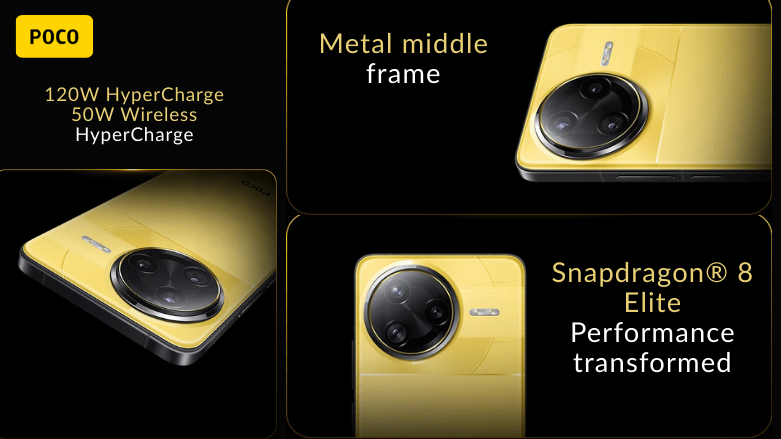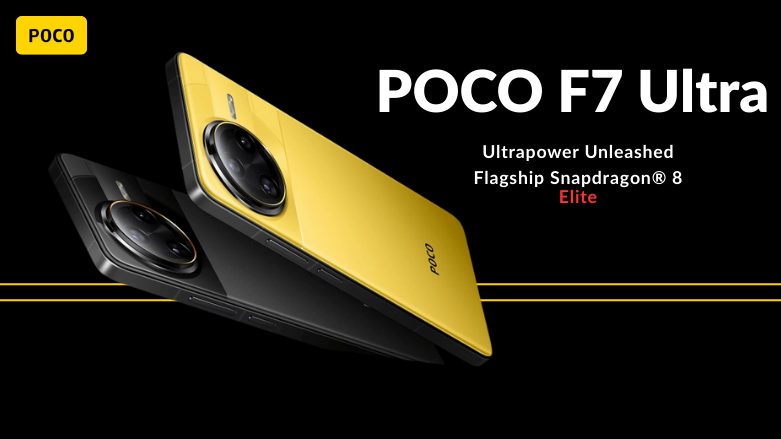Poco F7 Ultra Review OMG This Flagship Killer Is Perfect for 2025 The moment I unboxed the Poco F7 Ultra, I knew I was holding something special. Its polished glass back reflected the afternoon light beautifully, while the slim metal frame felt sturdy in my hand. This isn’t just another smartphone release it makes a statement. In this review, I’ll explain why the Poco F7 Ultra, powered by the Snapdragon 8 Elite and packed with impressive features from display to battery, truly deserves the “flagship killer” label. By the end of this article, you’ll understand why the Poco F7 Ultra is set to dominate 2025.
A Design That Combines Style and Strength
From the beginning, the Poco F7 Ultra strikes a balance between premium style and strong durability. The back panel uses toughened POCO Shield Glass, which offers twenty times the drop resistance of standard smartphone glass. With a carefully designed metal frame that doesn’t feel cold or slippery, you can show off this device at the office without worrying about accidental slips or bumps. Despite housing a large 5,300 mAh battery, the smartphone remains impressively slim at just 8.39 mm. Weighing in at 212 g, it has a reassuring heft without feeling like a burden.
The phone also has an IP68 rating for dust and water resistance, a feature that’s more necessary than luxurious these days. Whether you’re caught in a rain shower or accidentally spill coffee in the morning, this certification provides real peace of mind. While it’s best to avoid submersion at the beach or pool, I tested it under the sink for a few seconds without any problems. This combination of style and strength sets the tone for every other aspect of the phone.
Stunning Visuals That Set New Standards
If there’s one area where the Poco F7 Ultra truly stands out, it’s the 6.67-inch WQHD+ Flow AMOLED display. With a resolution of 2,560 × 1,440 and up to 3,200 nits of peak brightness, this screen performs remarkably well against glare. Text stays clear, even at small font sizes, and HDR10+ content looks cinematic with rich blacks and vibrant colors.
The adaptive 120 Hz refresh rate transforms everyday scrolling into a smooth experience. Whether you’re browsing social media or navigating menus, you’ll notice the fluidity right away. During gaming, the phone ramps up the touch sampling to 2,560 Hz in Game Turbo Mode, ensuring every tap registers without delay. For those who read on their phones at night, the TÜV Rheinland Low Blue Light and Flicker Free certifications help reduce eye strain. Additionally, circular polarization technology minimizes harshness for a gentler viewing experience.
Powered by Snapdragon 8 Elite and Vision Boost D7

At the core of this review is the Snapdragon 8 Elite Mobile Platform, built on a cutting-edge 3 nm process. With two prime cores reaching up to 4.32 GHz and six performance cores hitting 3.53 GHz, everything you do feels instant. In daily use, loading times for heavy apps like Adobe Rush were almost nonexistent, and switching between numerous Chrome tabs was seamless.
Gaming performance is exceptional, thanks to the integrated Adreno GPU, which provides a 44% increase in graphics throughput over its predecessor while using 46% less power. Poco also introduced the VisionBoost D7 chipset, a dedicated graphics co-processor that enhances visuals. It enables 120 FPS smart frame interpolation, delivering smooth gameplay, making demanding titles like Genshin Impact feel effortless. The 2K Super Resolution feature upscales textures in real time for sharper details than native resolution typically allows. Activating Game HDR dynamically adjusts contrast and brightness, enhancing shadows and highlights.
Keeping Cool Under Pressure
Maintaining top performance usually leads to overheating, but the Poco F7 Ultra’s LiquidCool Technology 4.0 ensures consistent results. Its 3D dual-channel IceLoop system covers 5,400 mm² of surface area, moving heat away from the SoC and camera modules. In my marathon gaming test lasting three hours at room temperature, the phone stayed within 3 °C of ambient. This impressive performance limits throttling.
Additionally, fifteen built-in temperature sensors work with AI-driven scenario recognition to adjust power distribution as needed. Whether I was streaming 4K videos, editing high-res photos, or engaged in a multiplayer game, the phone effectively managed temperatures without feeling like it would overheat.
Battery Life That Lasts All Day
With a 5,300 mAh battery packed into its sleek frame, the Poco F7 Ultra easily lasts through a full day of heavy use. On busy days filled with GPS navigation, social media browsing, video streaming, and light productivity, it outperformed my previous daily driver. On less demanding weeks, I even got a second day without needing to charge. When it’s time to recharge, the HyperCharge system can take your battery from 0 to 100% in just 34 minutes with the 120 W wired charger.
For those who prefer the convenience of wireless charging, the 50 W wireless HyperCharge (sold separately) charges the phone in around 75 minutes perfect for a quick boost during a break. Poco’s Surge P3 charging chipset and Surge G1 battery management help maintain at least 80% of the battery’s original capacity after 1,600 cycles. That kind of reliability is something most flagship phones can only dream of.
Poco F7 Ultra Summary https://www.po.co/global/product/poco-f7-ultra
| Spec | Details |
|---|---|
| Processor | Qualcomm Snapdragon 8 Elite (3 nm; 2×4.32 GHz Prime + 6×3.53 GHz Performance cores; Adreno™ GPU) |
| Display | 6.67″ WQHD+ (3200×1440) Flow AMOLED, 120 Hz adaptive refresh, 2,560 Hz touch sampling, 3,200 nits peak |
| RAM & Storage | 12 GB LPDDR5X + 256 GB UFS 4.1 or 16 GB LPDDR5X + 512 GB UFS 4.1 |
| Rear Cameras | • 50 MP main (f/1.6, 1/1.55″ sensor, OIS) • 50 MP telephoto (60 mm equiv., f/2.0, OIS) • 32 MP ultra‑wide (120° FOV, f/2.2) |
| Front Camera | 32 MP selfie (f/2.0), Dynamic Shot burst mode |
| Battery & Charging | 5,300 mAh; 120 W wired HyperCharge (0→100 % in ~34 min) 50 W wireless HyperCharge (~75 min) |
| Cooling | LiquidCool 4.0 IceLoop dual‑channel, AI‑driven thermal management |
| Connectivity | Dual‑SIM 5G SA/NSA; Wi‑Fi 7; Bluetooth 6.0; NFC; GNSS (GPS, Beidou, Galileo, GLONASS, QZSS, NavIC) |
| Durability | IP68 dust/water resistance; POCO Shield Glass (20× drop resistance) |
| Software | HyperOS 2 (Android‑based) with AI Writing, AI Interpreter, Gemini Overlay, Circle to Search |
| Dimensions & Weight | 160.26 × 74.95 × 8.39 mm; 212 g |
| Price (India) | ₹54,990 (12 GB + 256 GB) / ₹64,990 (16 GB + 512 GB) |
| Price (Global) | From ~$550 |
Samsung Galaxy Z Fold7 Review Unfolding the Ultimate Ultra Experience
Cameras That Capture Every Moment
In this review, I’ve praised the performance, but the camera setup deserves equal recognition. The primary 50 MP Light Fusion 800 sensor captures stunning colors and significant dynamic range, even in low light. SuperPixel technology combines four pixels into one larger 2.0 μm equivalent, reducing noise while keeping fine details.
The second 50 MP floating telephoto lens (60 mm equivalent, f/2.0) doubles as a macro lens, allowing you to focus as close as 10 cm. Portrait photos have natural bokeh, and distant scenes come into view clearly with true 2.5× optical zoom. Meanwhile, the 32 MP ultra-wide camera has a broad 120° field of view, perfect for expansive landscapes or group shots when you can’t step back any further.
Front selfies get their own 32 MP module with Dynamic Shots mode, letting you take a burst of frames and choose the best expression later. For videographers, 8K recording at 24 FPS and 4K at 60 FPS provide professional quality. Modes like Director, Dual-video, and Motion Tracking Focus complete a camera system competitive with higher-end flagships.
HyperOS 2: A Fast and Smart Interface
The Poco F7 Ultra runs HyperOS 2 on Android, providing a near-stock experience with useful enhancements. Animations are smooth, menus respond quickly, and unnecessary apps are kept to a minimum. But the real standout features are the AI tools: AI Writing and Speech Recognition assist in crafting messages without touching the keyboard, the AI Interpreter offers real-time translation for chats and calls, and Gemini Overlay integrates Google’s Gemini assistant into your workflow for brainstorming, image generation, or actions across apps
Circle to Search is a game‑changer. Just draw a circle around any text or image on your screen, and voilà Google search results pop up without you ever having to leave the app. And when you want to get creative, AI Film Mode and AI Erase Pro are at your fingertips: one tap turns your everyday clips into shareable mini‑movies, or lets you effortlessly brush away unwanted objects from your photos.
Connectivity and Durability
Whether you’re navigating bustling city streets or winding country roads, the Poco F7 Ultra’s Super Antenna Array and Surge T1S Tuner make sure you stay connected. Calls were crystal clear, and 5G speeds remained rock‑steady even inside concrete‑walled buildings. With dual‑SIM support for a wide range of 5G bands and Wi‑Fi 7 compatibility, your home network is future‑proof. Bluetooth 6.0 keeps your earbuds and wearables in sync with barely a hiccup, and the full suite of GNSS options GPS, Beidou, Galileo, GLONASS, QZSS, NavIC locks in your location fast and accurately.
Toss in IP68 dust and water resistance plus the tough‑as‑nails POCO Shield Glass, and you’ve got a phone that’s as rugged as it is refined ready for whatever your adventures throw at it.
Price, Variants, and Overall Value
Here’s the kicker: the price. In India, the 12 GB + 256 GB model starts at just ₹54,990, and stepping up to 16 GB + 512 GB bumps it to ₹64,990. Internationally, you can pick up the base version for around $550. For a phone that packs this much punch, those numbers almost seem too good to be true. These prices place the Poco F7 Ultra in the mid-range category, yet its performance, display, and features rival or even exceed those of phones costing $1,000 or more.
This is the essence of Poco: they offer flagship-level hardware at prices that make you take a second look. If you want high performance without spending a fortune, this is the phone to consider.
Why the Poco F7 Ultra Excels
Every flagship promises speed, battery life, and camera quality. However, it’s rare to find one that excels in all areas at such a reasonable price. The Poco F7 Ultra shines by combining Qualcomm’s Snapdragon 8 Elite power, VisionBoost D7 graphics, an amazing Flow AMOLED display, and a battery that charges quicker than most competitors.
From quick email checks to extended gaming sessions, and from capturing family memories to editing a quick vlog, the Poco F7 Ultra consistently delivers excellent results. It does this without fuss, gimmicks, or excessive cost.
In this review, I’ve shared my experiences over weeks of real-world testing. If you want a “flagship killer” that truly deserves the title and blends cutting-edge hardware with thoughtful software while offering unbeatable value, your search ends here. The Poco F7 Ultra doesn’t just set the bar; it shatters it.

